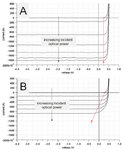cs3141592
Newbie level 3
Hi,
I am new to p-i-n photodiodes (PD) and struggling to understand an "odd" behavior in the data - see sets of IV in attached figure.
As the incident optical power level is increased the photodiode current increases ... but:
(A) for some PDs the "knee" (diode opening voltage) locations (red line) stays at positive voltage and does not change much
with optical power. For these PDs the signal (photocurrent) at zero bias is the same as the signal at negative bias since the IV curves are horizontal as they pass through the zero volt axis. This is shown as "typical" in many textbooks.
(B) for some PD's the "knee" moves to smaller and smaller voltage as the optical power is increased with the net result that at higher
optical power the signal at zero voltage is less than signal at large reverse bias ... i.e. the signal at zero volts appears "non-linear" or "saturated".
Even more puzzling sometimes (A) and (B) is the same device with (A) being case of light incident from the n-side of the p-i-n and (B) light incident from the p-side of the p-i-n.
I am curious if this is something that others may have seen and what would be the physics behind it.
Best Regards,
cs

I am new to p-i-n photodiodes (PD) and struggling to understand an "odd" behavior in the data - see sets of IV in attached figure.
As the incident optical power level is increased the photodiode current increases ... but:
(A) for some PDs the "knee" (diode opening voltage) locations (red line) stays at positive voltage and does not change much
with optical power. For these PDs the signal (photocurrent) at zero bias is the same as the signal at negative bias since the IV curves are horizontal as they pass through the zero volt axis. This is shown as "typical" in many textbooks.
(B) for some PD's the "knee" moves to smaller and smaller voltage as the optical power is increased with the net result that at higher
optical power the signal at zero voltage is less than signal at large reverse bias ... i.e. the signal at zero volts appears "non-linear" or "saturated".
Even more puzzling sometimes (A) and (B) is the same device with (A) being case of light incident from the n-side of the p-i-n and (B) light incident from the p-side of the p-i-n.
I am curious if this is something that others may have seen and what would be the physics behind it.
Best Regards,
cs
